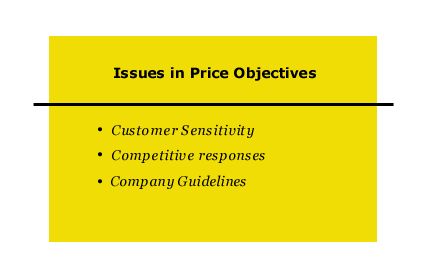BASIC STRATEGY GUIDE: STEP 20
Activity Three: Develop a pricing policy to improve the Company’s market share and returns.
Step 20: Set Objectives and Pricing Guidelines to exploit near term price opportunities.

What:
Develop specific objectives and guidelines for the pricing tactics to use with each Very Large and Large customer. Complement these objectives with broader guidelines to use with Medium and Small customers. To reach these objectives, consider the level of price sensitivity among customers and the likelihood that competition will attempt to counter our pricing moves.
Why:
The industry price outlook tells the Company the kinds of price pressures it is likely to face over the next three to five years. This step addresses the pricing guidelines the Company will need in order to improve its profitability within the next 12 – 18 months. This step leads to specific plans for each important customer.
What to Watch For:
-
Price differences among competitors exist because weaker competitors must discount in order to compete with the performance and price package of the stronger competitors.
-
Last Look develops over some time, beginning with the largest customers in the industry and moving to the smaller customers. It develops primarily because discounting competitors attack industry leaders who are in a Leader’s Trap.
-
The Company’s real competitors in customer relationships are its Peers, rather than the price discounting, Price Shavers.
-
As Last Look takes hold, Price Gaps within any customer relationship decline, though price differences from one customer to another will remain substantial.
-
The majority of customers and competitors are predictable in their relative pricing, so the Company may make its pricing plans around them. The tougher the market, though, the more likely it is that price declines start with customers, rather than competitors.
-
Three things determine a competitor’s likely response to our pricing initiative. Each of these forces is predictable:
-
The knowledge that the competitor has of our specific price move.
-
The capacity, or product availability, the competitor can bring to bear in response to our price move.
-
The will the competitor has to risk his profits in response to our price move.
-
-
If we are increasing our price, we would like competitors to:
-
have full knowledge of our price increase
-
be out of capacity
-
prefer an increase in margins to a near-term opportunity to increase sales by discounting
-
-
In a falling price environment, we prefer that only our customer, and no competitor, know of our low price offer. In this environment, virtually all competitors have excess capacity, and most would match declining prices if they knew of them. The exception would be a competitor in a Leader’s Trap.
-
The Company needs a specific set of guidelines for each current or potential major customer relationship, whether the customer is a Core customer. This set of guidelines considers both the price that the customer pays relative to other customers, as well the claim the customer has on our product capacity.
Action:
Set specific pricing objectives for each current and potential larger customer relationship and develop broad guidelines to use with current and potential smaller customers.
-
Worksheet #20A: Evaluating Price Sensitivity Among Customers
-
Worksheet #20B: Evaluating Competition and Their Knowledge, Capacity and Will
-
Worksheet #20C: Setting Company Pricing Objectives and Guidelines
More Information on Company Price Environment the Advanced Site >>
For helpful context on this step:
Videos:
Perspectives:
Symptoms and Implications:
-
Prices on niche products continue to rise while other prices fall
-
The industry has been able to preserve margins by increasing prices
-
Some competitors seek price increases more aggressively than others
-
Large competitors are maintaining price levels as smaller competitors discount
-
After high growth, demand has leveled and capacity has increased
